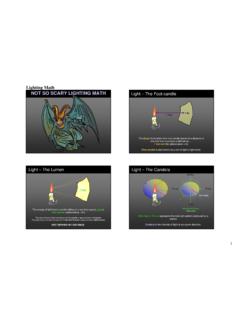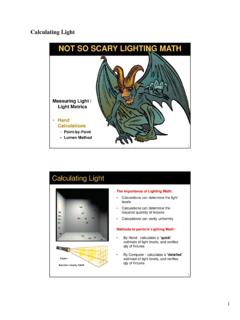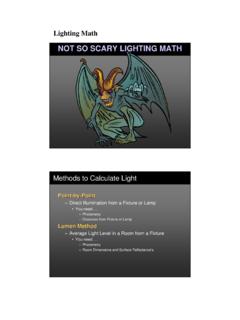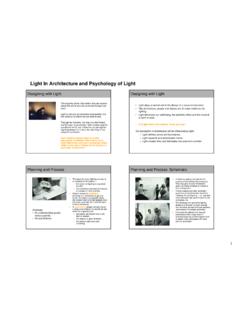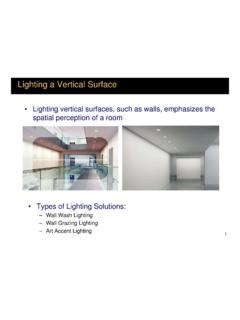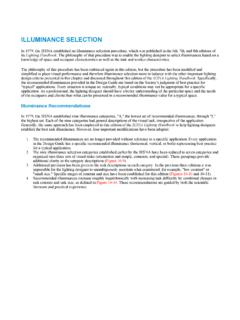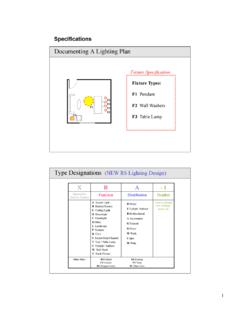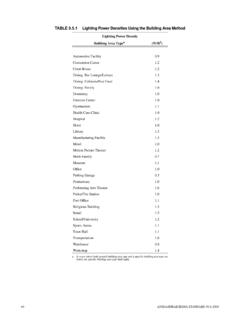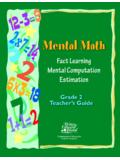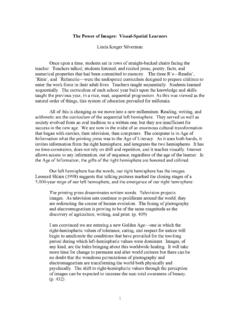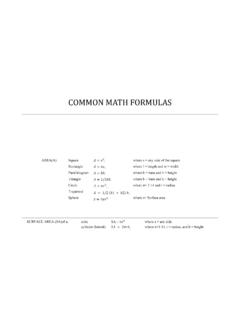Transcription of NOT SO SCARY LIGHTING MATH - RS Lighting Design
1 LIGHTING Math1 NOT SO SCARY LIGHTING MATHNOT SO SCARY LIGHTING MATHNOT SO SCARY LIGHTING MATHNOT SO SCARY LIGHTING MATHThe importance of LIGHTING math : Calculations can determine the light levels Calculations can determine the required quantity of fixtures Calculations can verify layoutMethods to perform LIGHTING math : By Hand By ComputerLighting Math2 Target Illuminance / Light LevelsWho Defines Light Levels?zIES of North America Recommended Practices Defines light levels and quality of illumination by task and applicationzCodes and RegulationszThe Owner Definitions: Task= the work performedApplications= the project type ( School, Commercial etc, IESNA Light Level recommendations are for Foot-candles at the work plane (2 6 AFF) They have limited significance to us when we interpret the actual environment.)
2 Such factors as LIGHTING walls, brightness accents, shadows, sparkle, and color have a greater influence on emotional reaction. IESNAIESNA ssrecommend light recommend light levels are for an age range of levels are for an age range of 40 40 55 years old55 years oldLighting Math3 AgesLess than Less than 40 years 40 years reduce Can reduce the light the light levels up to levels up to 1/3!1/3!Over 55 Over 55 years oldyears Can increase the increase the light levels light levels up to 2/3!up to 2/3!Standard Age Range is 40-55 years oldBabies require 3 times more light than a 20 year old!Babies require 3 times more light than a 20 year old!
3 Babies require 3 times more light than a 20 year old!IESNA Recommended Light LevelsLighting Math4 Summary Light Level (table 15)Measuring LightLuminance Measures how easy something is to see, or how bight a surface is emitting light energy Examples: backlit signage, a full moon, glowing wall Measured in: Foot-Lamberts (US) or Candelas per meter squared (metric)1 Foot-Lambert = Candelas/m2 Illuminance Measures how much light there is to see by, the light level to perform a task arriving LIGHTING energy Examples: emergency light level on the floor), Measured in: Foot-Candles (US) and Lux(Metric) LIGHTING Math5 FootFoot--candlecandleis known as a unit of light - direct illumination light levelDerived from one candle placed at a distance of one foot from a surface is defined as a footfoot--candlecandle(abbreviation = fc or FC)1 foot1 fcLight The Foot-candleThe energy of light from a candle falling on a one foot squareareaisOne Lumen(abbreviation = lm)
4 The total amount of light energy coming out of the candlecandleis approximately 13 lumens13 lumensThe total amount of light energy coming out of 100100--watt Awatt A--lamplampis approximately 1650 1650 lumenslumensNOT DEFINED BY DISTANCE1 lmLight The LumenLighting Math6 Candle Poweris the intensity value at any given direction.(unit is Candela, abbreviated as cp)Distribution CurveDistribution Curverepresents the total light intensity pattern produced by a sourceLight The CandelaDistribution CurvePolar Chart0 deg90 deg180 deg270 degCandelaCIE Luminaire Types / DistributionsDirectSemi-DirectGeneral Diffuse(IES)
5 Direct-IndirectSemi-IndirectIndirectLigh ting Math7 Candlepower Distribution Curve Candlepower Candlepower distribution curvesdistribution curvesprovides intuitive information on how aluminairewill perform CandelaCandelavalues are used in calculations to predict light levels0 deg102030405060708090 deg3003006006009009001200120015001500 Distribution anglesCandle Power DistributionAsymmetrical Distribution CurvePerpendicular 90 degreesCandlepower DistributionCandlepower DistributionParallel 0 degreesCandlepower DistributionCandlepower DistributionRectangular Tubular Fluourescent fixtureRectangular Tubular Fluourescent fixture90 deg Perpendicular0 deg ParallelLighting Math8 Light MeasurementMeasures the candlepower distribution of a particular lamp or is generated in a --Photometric reportIntegrating SphereThe Spectro-RadiometerGonio-PhotometerLumens versus Candelas LumenLumenis an amount of ENERGY CandelaCandelais an amount of INTESITY Light output from lamps and fixtures be measured in LumensLumensand CandelasCandelas.
6 Fixtures alter LumenLumenand Candela Candela output (Their values can only be found in Photometry Reports) LIGHTING Math9 Plot of candlepower values Summary of candlepower values in different planes Fixture Efficiency Lumen Summary Luminance summary Spacing criteria(SC) or Spacing/Mounting Height (S/MH) for uniformity Coefficient of Utilization Table GuidesPhotometry ReportsPhotometry Reports: sample 1 Open DownlightLighting Math10 Photometry Reports: sample 2 Indirect PendantPhotometry Reports: sample 3 Ceiling FixtureLighting Math11 Hand Methods to Calculate LightMnfrs GuidesMnfrs Guides Direct or Average Illumination from a Fixture or Lamp Recommended spacing or layoutPointPoint--byby--PointPoint Direct light level from a Fixture or LampLumen MethodLumen Method Average Light Level in a Room from a Fixture Can be used to determine quantity needed Point-by-PointFoot-candle =Candle PowerDistance2 Ceiling height = 9ftLight Level at FloorFC = 2651candelas/ 9ft2FC = 2651 / 81FC = foot-candlesLighting Math12 Ceiling Fixture ExampleFoot-candle =2 Point-by-PointFoot-candle =Candle
7 PowerDistance2 Determine the Light Level at TableCeiling height = 9ftFC = ____ candelas/ ___ ft2FC = _____ foot-candlesCeiling height = 8ftCorridor Width = 6 ftEye Level = the Light Level at the WallPoint-by-PointFoot-candle =Candle PowerDistance2 Ceiling Fixture ExampleDLighting solve for D, you the Drawing, TrigonometryTrigonometryAA22+ B+ B22= C= + 32= + 9 = C2C= ( + 9)C= (approx4ft)Foot-candle =Candle PowerDistance2 Ceiling height = 8ftCorridor Width = 6 ftEye Level = the Light Level at the Wall Ceiling Fixture ExampleDPoint-by-PointFoot-candle =Candle solve for Angle, you the Drawing, TrigonometryTrigonometryTan(Angle) = Opp / AdjAngle = Tan-1(Opp / Adj)Angle = Tan-1(3 / )Angle = 50 degrees?
8 ?Ceiling height = 8ftCorridor Width = 6 ftEye Level = the Light Level at the Wall Ceiling Fixture Example4ftLighting Math14 Point-by-PointFC = ____ candelas/ ___ ft2FC = ____ foot-candlesFoot-candle =Candle PowerDistance2 Ceiling height = 8ftCorridor Width = 6 ftEye Level = the Light Level at the Wall Ceiling Fixture Example4ft50degPoint-by-Point Factors Calculated Levels are Facing the Light Fixture With the exception of directly belowLighting Math15 Point-by-Point Factors You need to factor an adjustment if you want levels at other angles (IE Horizontal, Vertical Angles) COSINE Adjusted!
9 !COSINE Adjusted!!HorizontalVerticalVerticalCOSI NE AdjustmentsFoot-candle =Candle PowerDistance2X COS(Angle of Incidence) Light SourceIncidenceReflectanceLighting COSINE AdjustmentFC = CP/D2x COS(angle)What is the Angle of Incidence?FC = x COS ( ___ deg)FC = ____ foot-candlesCeiling height = 8ftCorridor Width = 6 ftEye Level = the Light Level at the Wall Ceiling Fixture Example4ft50degMethods to Calculate LightPointPoint--byby--PointPoint Direct Illumination from a Fixture or Lamp You Photometry Distances from Fixture or LampLumen MethodLumen Method Average Light Level in a Room from a Fixture You Photometry Room Dimensions and Surface Reflectance'sLighting Math17 Room Reflectance Room comprised of Walls, Ceiling, and Floor.
10 Walls typically have Doors and Windows All surfaces have a reflectance value to bounce light. Light from Light Fixture bounces off of all Reflectance Surfaces with less reflectance will bounce less light Typical Reflectance Values: 75%75%--90%90%White, Off White, Grey, Light tints of Blue or Brown 30%30%--60% 60% Medium Green, Yellow, Brown, or Grey 10%10%--20% 20% Dark Grey, Medium Blue 5%5%--10%10%Dark Blue, Brown. Dark Green, and many wood finishes LIGHTING Math18 Calculations using Lumens Lumen Method Calculation Calculates the Average Illuminationfor a room. Takes into account the room surface reflectance's but assumes the surfaces are diffuse (not shiny!)
